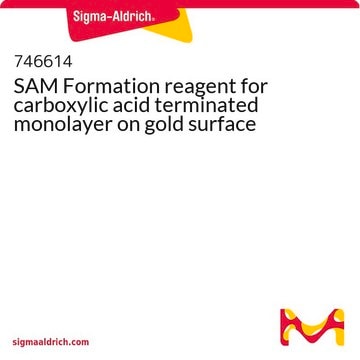674397
11-Amino-1-undecanethiol hydrochloride
97%
Synonyme(s) :
AUT, 11-Aminoundecanethiol hydrochloride, 11-Mercaptoundecylamine, MUAM
About This Item
Produits recommandés
Pureté
97%
Forme
solid
Pf
120-170 °C
Température de stockage
2-8°C
Chaîne SMILES
Cl[H].NCCCCCCCCCCCS
InChI
1S/C11H25NS.ClH/c12-10-8-6-4-2-1-3-5-7-9-11-13;/h13H,1-12H2;1H
Clé InChI
LOQACAFAHHWTBJ-UHFFFAOYSA-N
Catégories apparentées
Description générale
Application
It can also be self-assembled onto gold electrodes for a study on the effect of terminal groups on the redox responses of ferrocene derivatives using the voltammetric method.
Mention d'avertissement
Warning
Mentions de danger
Conseils de prudence
Classification des risques
Eye Irrit. 2 - Skin Irrit. 2 - STOT SE 3
Organes cibles
Respiratory system
Code de la classe de stockage
11 - Combustible Solids
Classe de danger pour l'eau (WGK)
WGK 3
Point d'éclair (°F)
Not applicable
Point d'éclair (°C)
Not applicable
Équipement de protection individuelle
dust mask type N95 (US), Eyeshields, Gloves
Certificats d'analyse (COA)
Recherchez un Certificats d'analyse (COA) en saisissant le numéro de lot du produit. Les numéros de lot figurent sur l'étiquette du produit après les mots "Lot" ou "Batch".
Déjà en possession de ce produit ?
Retrouvez la documentation relative aux produits que vous avez récemment achetés dans la Bibliothèque de documents.
Les clients ont également consulté
Articles
Recent research highlights tunable properties of inorganic nanoparticles, driving interest in optoelectronics.
Self-assembled monolayers (SAMs) have diverse applications; article compares benefits of alkylthiolates on gold SAM systems.
Notre équipe de scientifiques dispose d'une expérience dans tous les secteurs de la recherche, notamment en sciences de la vie, science des matériaux, synthèse chimique, chromatographie, analyse et dans de nombreux autres domaines..
Contacter notre Service technique












